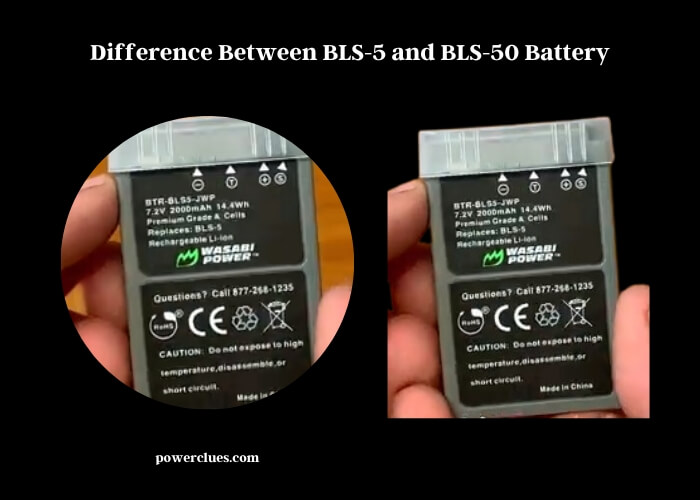Difference Between BLS-5 and BLS-50 Battery
The key differences between BLS-5 and BLS-50 batteries are primarily linked to the aspects of capacity, size, weight, and compatibility. Both batteries show variance in their performance, lifespan, recharge time, technology, and price.
BLS-5 and BLS-50 batteries may appear similar, but they have distinctive features. The capacity of a battery indicates how much power it can store, and here, the BLS-50 usually offers an enhanced capacity compared to the BLS-5. This leads to a longer usage time before the battery needs to be recharged.

The size and weight of the batteries also play a role in distinguishing them. The BLS-50 battery is generally lighter and more compact than the BLS-5, which can make a significant difference in usage, particularly in handheld devices like cameras.
Compatibility is another crucial aspect. BLS-50 batteries are designed to be compatible with a wider range of devices than the BLS-5. The BLS-50’s advanced technology supports this compatibility range, providing superior performance and efficiency.
Performance and lifespan vary between these batteries. The BLS-50 is often noted for its longer lifespan and consistent performance over time, thanks to its enhanced technology and design. Meanwhile, the recharge time for the BLS-50 is usually shorter than that of the BLS-5, making it more convenient for users.
The price is the final distinguishing factor. Given its superior features and benefits, the BLS-50 usually comes at a higher price than the BLS-5. Therefore, users need to weigh their needs and preferences against the cost when choosing between these two battery types.
BLS Battery Basics
The Olympus BLS Series: A Brief Overview
The Olympus BLS series serves as the power source for numerous digital cameras and other devices. With the series’ reputable standing in the market, two models in particular, the BLS-5 and BLS-50, have garnered significant attention. Known for their reliable performance, these batteries both pack a punch but differ in various aspects. Hence, we delve into the details of each, showcasing their unique attributes and performance.

Features and Specifications
BLS-5: Core Characteristics and Technical Specifications
The BLS-5 is a high-performance rechargeable lithium-ion battery designed for select Olympus cameras. It has a power capacity of 1210mAh, enabling long-lasting performance. The BLS-5 operates at a voltage of 7.2V, giving your device the strength it needs to function optimally.
BLS-5 Battery Features and Specifications
| Battery Model | Battery Type | Voltage | Capacity |
| BLS-5 | Lithium-Ion | 7.2V | 1210mAh |
BLS-50: Core Characteristics and Technical Specifications
The BLS-50, on the other hand, is a more recent lithium-ion rechargeable battery, also used in various Olympus cameras. With a capacity of 1175mAh and operating at the same voltage as BLS-5, the BLS-50 aims to provide reliable power supply for your device.
BLS-50 Battery Features and Specifications
| Battery Model | Battery Type | Voltage | Capacity |
| BLS-50 | Lithium-Ion | 7.2V | 1175mAh |
Pros and Cons
BLS-5: Strengths and Limitations
The BLS-5 excels in terms of capacity. Its 1210mAh power capacity gives it a slight edge over the BLS-50. Consequently, the BLS-5 may last slightly longer during intense usage. However, it’s worth noting that the BLS-5 is an older model, meaning it lacks some of the enhancements found in the newer BLS-50.
BLS-50: Strengths and Limitations
Though the BLS-50 has a slightly lower power capacity, it boasts updated technology. It has better performance stability, ensuring that your device continues to operate smoothly even as the battery begins to run low. Yet, the slight decrease in capacity might shorten its runtime in high-drain scenarios compared to the BLS-5.
Comparing BLS-5 and BLS-50
Direct Comparison: BLS-5 Vs. BLS-50
The BLS-5 and BLS-50 are comparable in many ways. Both are lithium-ion rechargeable batteries that offer dependable power to Olympus devices. But their differences lie in their power capacities and technological updates.
BLS-5 Vs BLS-50 – A Comparative Table
| Feature | BLS-5 | BLS-50 |
| Battery Type | Lithium-Ion | Lithium-Ion |
| Voltage | 7.2V | 7.2V |
| Capacity | 1210mAh | 1175mAh |
| Technology | Older | More recent |
Lifespan and Longevity: BLS-5 Vs. BLS-50
Despite having a slight edge in capacity, the BLS-5 does not necessarily surpass the BLS-50 in terms of lifespan. The latter’s more recent technology can lead to more efficient power management, potentially allowing it to last longer under similar usage conditions.
Performance Under Stress: BLS-5 Vs. BLS-50
The BLS-50’s modern technology also plays a key role in handling high stress. Compared to the BLS-5, it exhibits more stability under high-use conditions, maintaining consistent device performance throughout its discharge cycle.
Compatibility and Cost Analysis
Device Compatibility: BLS-5 Vs. BLS-50
The BLS-5 and BLS-50 batteries are designed to be compatible with a range of Olympus devices. However, with the BLS-50 being a more recent addition, it aligns with newer Olympus devices, while the BLS-5 caters to older models. Always ensure to check your device’s manual for specific battery compatibility information.
Cost Vs. Performance: Evaluating BLS-5 and BLS-50
In terms of cost, the BLS-5 and BLS-50 batteries may differ slightly depending on the retailer. While the BLS-50 might cost slightly more due to its updated technology, the BLS-5 might still be more cost-effective for users needing the extra power capacity.
Making the Choice: BLS-5 Vs BLS-50
Factors in the Decision Process: Choosing Between BLS-5 and BLS-50
In deciding between the BLS-5 and BLS-50, you should consider factors like your specific device, the use case, and the performance you expect from the battery. Your budget also plays a role. If your device is compatible with both batteries, the BLS-5 could be more appealing if you require a higher power capacity, while the BLS-50 might be a better choice for newer Olympus devices or in scenarios requiring consistent performance under high-use conditions.
In conclusion, the difference between the BLS-5 and BLS-50 batteries lies in their power capacities and their respective technologies. Each has its strengths and might be the better choice depending on the specific use case. Hopefully, this comparison sheds some light on these two notable batteries, enabling you to make a more informed decision.
Read more:
